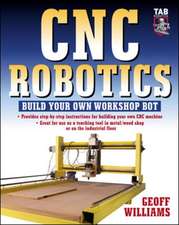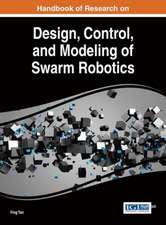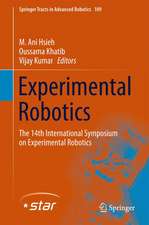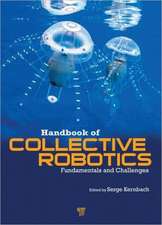Robot Navigation from Nature: Simultaneous Localisation, Mapping, and Path Planning Based on Hippocampal Models: Springer Tracts in Advanced Robotics, cartea 41
Autor Michael John Milforden Limba Engleză Paperback – 22 oct 2010
| Toate formatele și edițiile | Preț | Express |
|---|---|---|
| Paperback (1) | 940.87 lei 6-8 săpt. | |
| Springer Berlin, Heidelberg – 22 oct 2010 | 940.87 lei 6-8 săpt. | |
| Hardback (1) | 943.88 lei 6-8 săpt. | |
| Springer Berlin, Heidelberg – 11 feb 2008 | 943.88 lei 6-8 săpt. |
Din seria Springer Tracts in Advanced Robotics
- 18%
 Preț: 910.26 lei
Preț: 910.26 lei - 18%
 Preț: 893.71 lei
Preț: 893.71 lei -
 Preț: 445.98 lei
Preț: 445.98 lei -
 Preț: 406.43 lei
Preț: 406.43 lei - 13%
 Preț: 371.07 lei
Preț: 371.07 lei - 17%
 Preț: 378.35 lei
Preț: 378.35 lei - 15%
 Preț: 640.88 lei
Preț: 640.88 lei - 18%
 Preț: 783.98 lei
Preț: 783.98 lei - 15%
 Preț: 641.74 lei
Preț: 641.74 lei - 15%
 Preț: 640.88 lei
Preț: 640.88 lei - 18%
 Preț: 994.72 lei
Preț: 994.72 lei - 18%
 Preț: 778.45 lei
Preț: 778.45 lei - 18%
 Preț: 730.35 lei
Preț: 730.35 lei - 18%
 Preț: 1233.83 lei
Preț: 1233.83 lei - 18%
 Preț: 951.47 lei
Preț: 951.47 lei - 15%
 Preț: 640.06 lei
Preț: 640.06 lei - 18%
 Preț: 1844.67 lei
Preț: 1844.67 lei - 15%
 Preț: 642.51 lei
Preț: 642.51 lei - 18%
 Preț: 1112.30 lei
Preț: 1112.30 lei - 15%
 Preț: 665.08 lei
Preț: 665.08 lei - 18%
 Preț: 947.85 lei
Preț: 947.85 lei - 15%
 Preț: 640.88 lei
Preț: 640.88 lei - 18%
 Preț: 776.88 lei
Preț: 776.88 lei - 18%
 Preț: 959.04 lei
Preț: 959.04 lei - 15%
 Preț: 659.02 lei
Preț: 659.02 lei - 15%
 Preț: 654.95 lei
Preț: 654.95 lei - 18%
 Preț: 973.38 lei
Preț: 973.38 lei - 5%
 Preț: 724.70 lei
Preț: 724.70 lei - 18%
 Preț: 981.49 lei
Preț: 981.49 lei - 18%
 Preț: 954.45 lei
Preț: 954.45 lei - 15%
 Preț: 641.53 lei
Preț: 641.53 lei - 15%
 Preț: 653.98 lei
Preț: 653.98 lei - 24%
 Preț: 814.81 lei
Preț: 814.81 lei - 18%
 Preț: 968.65 lei
Preț: 968.65 lei - 18%
 Preț: 970.70 lei
Preț: 970.70 lei
Preț: 940.87 lei
Preț vechi: 1147.41 lei
-18% Nou
Puncte Express: 1411
Preț estimativ în valută:
180.03€ • 188.47$ • 148.97£
180.03€ • 188.47$ • 148.97£
Carte tipărită la comandă
Livrare economică 05-19 aprilie
Preluare comenzi: 021 569.72.76
Specificații
ISBN-13: 9783642096266
ISBN-10: 3642096263
Pagini: 216
Ilustrații: XX, 196 p.
Dimensiuni: 155 x 235 x 11 mm
Greutate: 0.31 kg
Ediția:Softcover reprint of hardcover 1st ed. 2008
Editura: Springer Berlin, Heidelberg
Colecția Springer
Seria Springer Tracts in Advanced Robotics
Locul publicării:Berlin, Heidelberg, Germany
ISBN-10: 3642096263
Pagini: 216
Ilustrații: XX, 196 p.
Dimensiuni: 155 x 235 x 11 mm
Greutate: 0.31 kg
Ediția:Softcover reprint of hardcover 1st ed. 2008
Editura: Springer Berlin, Heidelberg
Colecția Springer
Seria Springer Tracts in Advanced Robotics
Locul publicării:Berlin, Heidelberg, Germany
Public țintă
ResearchCuprins
Mapping and Navigation.- Robotic Mapping Methods.- Biological Navigation Systems.- Emulating Nature: Models of Hippocampus.- Robotic or Bio-inspired: A Comparison.- Pilot Study of a Hippocampal Model.- RatSLAM: An Extended Hippocampal Model.- Goal Memory: A Pilot Study.- Extending RatSLAM: The Experience Mapping Algorithm.- Exploration, Goal Recall, and Adapting to Change.- Discussion.
Recenzii
From the reviews:
“This book is written for researchers, graduate students, and professionals in robotics, especially robot navigation and computational neuroscience. The hippocampus has been studied extensively in rodents as part of the brain system responsible for navigation and spatial memory … .” (IEEE Control Systems Magazine, Vol. 30, April, 2010)
“This book is written for researchers, graduate students, and professionals in robotics, especially robot navigation and computational neuroscience. The hippocampus has been studied extensively in rodents as part of the brain system responsible for navigation and spatial memory … .” (IEEE Control Systems Magazine, Vol. 30, April, 2010)
Textul de pe ultima copertă
This book describes the development of a robot mapping and navigation system inspired by models of the neural mechanisms underlying spatial navigation in the rodent hippocampus. Computational models of animal navigation systems have traditionally had limited performance when implemented on robots. The aim of the work was to determine the extent to which hippocampal models can be used to provide a robot with functional mapping and navigation capabilities in real world environments. The focus of the research was on achieving practical robot performance, rather than maintaining biological plausibility.
Caracteristici
one of the first serious explorations and implementations of bio-inspired navigation" Professor Hugh F Durrant-Whyte, Australian Research Council Federation Fellow Presents pioneering work into understanding, designing, and implementing bio-inspired navigation techniques within a robotics context First research to test existing models of rodent spatial mapping and navigation on robots in large, challenging, real world environments an excellent summary of the state-of-the-art in robot navigation together with a good summary of work in modelling navigation in different animal species" Prof Hugh F Durrant-Whyte

















